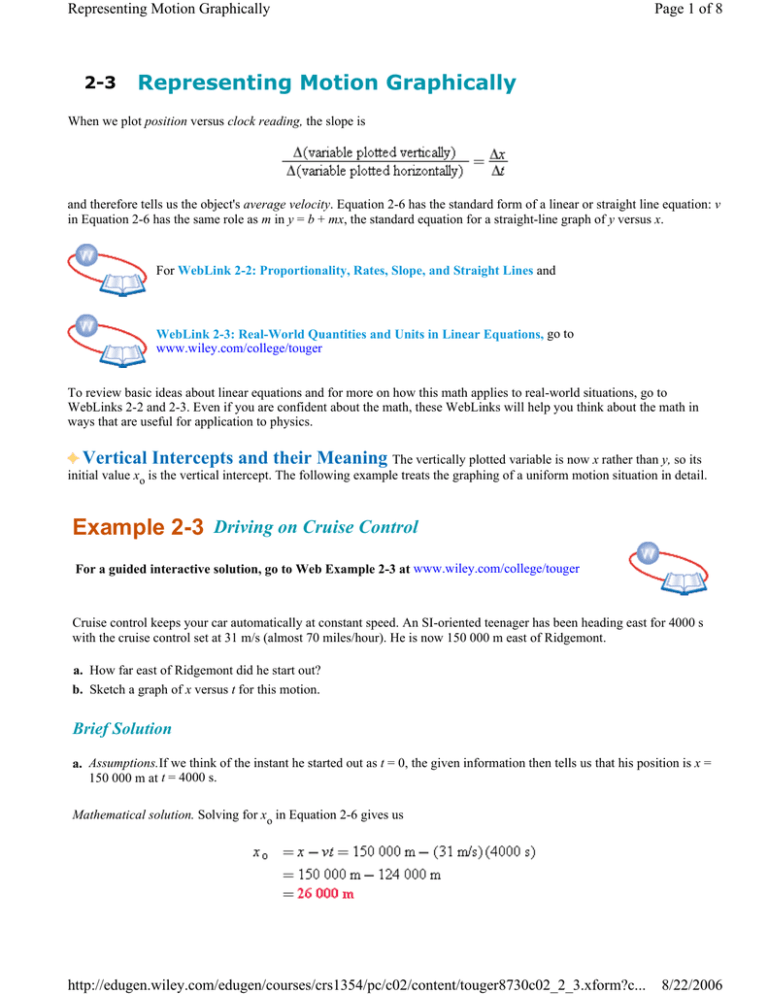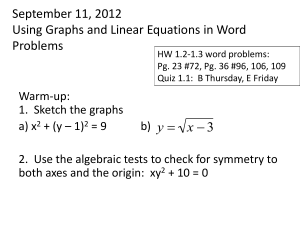
Representing Motion Graphically
2-3
Page 1 of 8
Representing Motion Graphically
When we plot position versus clock reading, the slope is
and therefore tells us the object's average velocity. Equation 2-6 has the standard form of a linear or straight line equation: v
in Equation 2-6 has the same role as m in y = b + mx, the standard equation for a straight-line graph of y versus x.
For WebLink 2-2: Proportionality, Rates, Slope, and Straight Lines and
WebLink 2-3: Real-World Quantities and Units in Linear Equations, go to
www.wiley.com/college/touger
To review basic ideas about linear equations and for more on how this math applies to real-world situations, go to
WebLinks 2-2 and 2-3. Even if you are confident about the math, these WebLinks will help you think about the math in
ways that are useful for application to physics.
Vertical Intercepts and their Meaning The vertically plotted variable is now x rather than y, so its
initial value xo is the vertical intercept. The following example treats the graphing of a uniform motion situation in detail.
Example 2-3 Driving on Cruise Control
For a guided interactive solution, go to Web Example 2-3 at www.wiley.com/college/touger
Cruise control keeps your car automatically at constant speed. An SI-oriented teenager has been heading east for 4000 s
with the cruise control set at 31 m/s (almost 70 miles/hour). He is now 150 000 m east of Ridgemont.
a. How far east of Ridgemont did he start out?
b. Sketch a graph of x versus t for this motion.
Brief Solution
a. Assumptions.If we think of the instant he started out as t = 0, the given information then tells us that his position is x =
150 000 m at t = 4000 s.
Mathematical solution. Solving for xo in Equation 2-6 gives us
http://edugen.wiley.com/edugen/courses/crs1354/pc/c02/content/touger8730c02_2_3.xform?c...
8/22/2006
Representing Motion Graphically
Page 2 of 8
b. We need two points to determine a straight line. We now know x at two instants t because xo is by definition the value
of x at t = 0. We can therefore plot the two points (t = 0, x = 26 000 m) and (t = 4000 s, x = 150 000 m) and draw the
straight line connecting them. The resulting graph is shown at left.
Related homework: Problems 2-18 and 2-19.
Interpreting Slope Positions and velocities, and also the slopes that represent velocities, may be either positive
or negative. To reinforce your understanding of how the signs work in various situations, consider Figure 2-6. Parts a and b
show the positions of four cars at two different instants (t = 0 and t = 4 s). We shall assume that each car is being driven at
uniform velocity. Note that when the cars are to the left of the origin they have negative positions.
http://edugen.wiley.com/edugen/courses/crs1354/pc/c02/content/touger8730c02_2_3.xform?c...
8/22/2006
Representing Motion Graphically
Page 3 of 8
Figure 2-6 Representations of uniform motion. We can use either pictures (a and b), equations (c), or graphs (d) to comm
motion. As you come to understand them better, these different ways of representing the motion should reinforce each other
In Figure 2-6c, we use two positions x and the corresponding instants t to calculate the average velocity of each car. For
each car, the two pairs of values give us two points on a plot of x versus t (Figure 2-6d). The two points determine the
straight line graph for that car. Each average velocity in c is the slope of the corresponding graph in d. The graphs have
constant slope—that's what makes them straight lines—because the cars are moving at constant velocity.
Let's see what some of the features of the graphs in d represent. (Note: If possible, you should try to explore these motions
with a motion detector.)
Feature of Graph(s)
Aspect of Motion Represented
The graphs for cars A and C slant upward to the right
(their slopes are positive).
Cars A and C are moving toward the right. Their
displacements as time advances are positive; thus, their
velocities are positive.
The graphs for cars B and D slant downward to the
right (their slopes are negative).
Cars B and D are moving toward the left, giving negative
displacements and therefore negative velocities.
The graphs for cars B and C lie below the horizontal
axis.
Cars B and C are to the left of the origin throughout the
interval, so their positions x are always negative.
http://edugen.wiley.com/edugen/courses/crs1354/pc/c02/content/touger8730c02_2_3.xform?c...
8/22/2006
Representing Motion Graphically
Page 4 of 8
The graph for car C lies below the x axis, but the slope
is positive.
C is positioned to the left of the origin during this interval but
is moving toward the right.
The graph for car D lies above the x axis, but the slope
is negative.
D is positioned to the right of the origin during this interval
but is moving toward the left.
A's graph is steeper than C's (the scale is the same).
A is going at greater speed than C (also at greater velocity).
B's graph is steeper (more nearly vertical) than D's. Its
slope is more negative, so the absolute value of its
slope is greater.
B is going at greater speed than D (but not at greater
velocity—a more negative number is not greater than a less
negative number).
The idea of slope, a property of a straight line, can also be applied to nonuniform motion, such as the motion graphed in
Figure 2-7a. If you draw a straight line segment or secant connecting the points P1 and P2 on the graph, its slope is
, which is the average velocity v . The straight line segment connecting points P2 and P3 has a greater
slope, so the average velocity is greater over this interval. Interval by interval, the slopes of the straight secants tell us about
the motion represented by the curve.
Figure 2-7 Interpreting slope for graphs of nonuniform motion.
If we want to know about instantaneous velocity, we can zoom in until we are looking at a segment of the curve that still
includes the instant in question, but is so tiny that it is essentially straight (Figure 2-7b). In the same way, as Figure 2-7c
shows, a small stretch of ocean surface on a windless day may appear flat, even though the Earth is round. To help see how
the segments are sloping, we extend them (dotted in Figure 2-7b). Each extended line is very nearly a tangent, a line that
just grazes the graph at a single point. So we can pick a tiny close-up segment of the curve that includes a certain instant t,
and we can take the slope of this segment to be a very good approximation to the instantaneous velocity at t. In other words,
we find the instantaneous velocity approximately by applying Procedure 2-1 to this tiny segment.
Graphs are a concise way of communicating a great deal of information about the motion of an object, whether uniform
(constant velocity) or not. It is therefore important for you to learn to read their features. WebLink 2-4 provides an
opportunity to develop some experience with this. Figure 2-8 summarizes the motions treated in the WebLink and their
graphs.
http://edugen.wiley.com/edugen/courses/crs1354/pc/c02/content/touger8730c02_2_3.xform?c...
8/22/2006
Representing Motion Graphically
Page 5 of 8
Figure 2-8 (a) Graphs of position versus clock reading for cars with constant (A) and nonconstant (B–E) velocities. S
for more detail. (b) Picturing the motions described by these graphs. The centers of the cars are at the graphed positions.
Graphs of v Versus t
For WebLink 2-4: Interpreting Motion Graphs, go to www.wiley.com/college/touger
We have already seen how to use the idea of slope to find the instantaneous velocity v at each instant t. Because we can find
a value of v for each value of t, we can also graph v versus t. Figure 2-9a shows x versus t (from Figure 2-7a) and v versus t
graphs for the same motion. In the following table, note how the features of the v versus t graph correspond to those of the x
versus t graph.
Graph of x versus t
Graph of v versus t
What Object Is
Doing
From t1 to t2
Graph gets steeper; slope
increases
v increases in value; graph rises
Speeding up
At t2
Graph is steepest; slope of
tangent is at maximum value
v has maximum value; graph peaks
Going fastest
http://edugen.wiley.com/edugen/courses/crs1354/pc/c02/content/touger8730c02_2_3.xform?c...
8/22/2006
Representing Motion Graphically
Page 6 of 8
From t2 to t3
Graph “levels off”; slope
decreases
v decreases; graph goes back down
Slowing down
For entire period
covered by graph
Graph slants upward toward
the right throughout
Values of v are always positive; thus,
all points are above horizontal axis
Always moving
toward the right
Figure 2-9 Graphs of x versus t and v versus t for the same nonuniform motion. (a) In the x versus t plot, the slopes of
the tangents give the velocities. (b) In the v versus t plot, those slopes are plotted against t. Note that the horizontal tangent
at t1 has zero slope.
Example 2-4 Sketching v versus t Graphs
Figure 2-10 displays x versus t plots for two different moving objects. Sketch a graph of instantaneous velocity v versus
clock reading t for each of these motions.
Figure 2-10 x versus t graphs for two different moving objects.
Solution
Get the picture. We first pick tiny segments of the curve at some typical values of t, because the slopes of these segments
are roughly the instantaneous velocities at those values of t. This is done in Figure 2-11.
http://edugen.wiley.com/edugen/courses/crs1354/pc/c02/content/touger8730c02_2_3.xform?c...
8/22/2006
Representing Motion Graphically
Page 7 of 8
Figure 2-11 The slopes of tiny segments of the graph give us the instantaneous velocities at different values of t.
See how v changes with t. We see in Figure 2-11 that the slope of graph a is first negative (at t1), then zero (at t2), and
then positive (at t3). Thus, the value of v goes from negative to zero to positive; like the slope that represents it, v is
always increasing. The graph of v versus t must show v behaving in this way. The v versus t plot sketched in Figure 2-12a
shows the required behavior.
Figure 2-12 These graphs of velocity versus t are for the same motions as the x versus t graphs in Figures 2-10
and 2-11.
In contrast, the slope of graph b in Figure 2-11 is first positive (at t1), then zero (at t2), and then negative (at t3). The value
of v likewise goes from positive to zero to negative; it is always decreasing. This behavior is displayed by the v versus t
plot sketched in Figure 2-12b.1
Related homework: Problems 2-22, 2-23, and 2-24.
For WebLink 2-5: Graphs of Motion on a Ramp, go to www.wiley.com/college/touger
Figures 2-13a and 2-13b show real-world objects whose velocities behave in the manner described by the graphs in Figure
2-12 when set in motion by an initial push. You can see the graphs develop as the motions are animated in WebLink 2-5.
http://edugen.wiley.com/edugen/courses/crs1354/pc/c02/content/touger8730c02_2_3.xform?c...
8/22/2006
Representing Motion Graphically
Page 8 of 8
Figure 2-13 These situations exhibit the motions that are graphed in Figures 2-10 through 2-12. In (a), the hand
gives the car an initial velocity downhill. The net force on the car is uphill. In (b), the initial velocity is uphill, the net force
downhill.
Copyright © 2004 by John Wiley & Sons, Inc. or related companies. All rights reserved.
http://edugen.wiley.com/edugen/courses/crs1354/pc/c02/content/touger8730c02_2_3.xform?c...
8/22/2006


